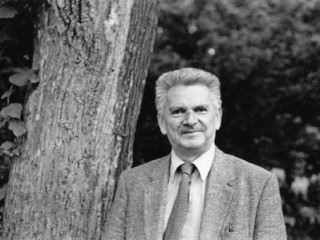
Rene Thom biography
Date of birth : 1923-09-02
Date of death : 2002-10-25
Birthplace : Montbéliard, France
Nationality : French
Category : Science and Technology
Last modified : 2011-09-23
Credited as : mathematician, ,
0 votes so far
Thom was born in a small town in France near Switzerland's border. His parents were shopkeepers. He took to mathematics at an early age, by some accounts learning to visualize shapes in four-dimensional space by the age of ten. His mathematical talents won him a scholarship. He received a university degree in mathematics in 1940, shortly before Hitler invaded France. He went on to earn a degree in philosophy in 1941. He continued his studies at the Ecole Normale Superieure in Paris, where he was a student from 1943 to 1946. Also during this time, he married and started a family. He finally completed his studies in 1951, when he received a Ph.D. Soon afterward, he traveled to the United States for a year of post-doctoral work at Princeton University, where he met Albert Einstein. Returning to France, Thom became a professor and continued his research.
In the 1950s, Thom, working with Hassler Whitney, created two new branches of mathematics called differential topology and singularity theory. These theories allow researchers to mathematically manipulate spheres in higher dimensions of space beyond the three that we live in. Higher dimensional spheres are called manifolds, and Thom created a way to examine the intersections of manifolds that have been mapped onto one another. The points where the manifolds intersect are called singularities, and, along with manifolds, are considered essential to a deep understanding of geometry. This work led to Thom's being awarded the Fields Medal in 1958. This is the highest honor that can be awarded to mathematicians, equivalent to the Nobel Prize.
In 1964, Thom joined the faculty of the Institut des Hautes Etudes Scientifique (Institute of Advanced Scientific Studies), which is one of the most renowned scientific institutions in France. Thom remained at this institution, based in Bures-sur-Yvette, outside of Paris, for the remainder of his career. It was here that Thom began work on what was to become one of his best-known theories: catastrophe theory. This theory, which applied the principals of manifolds and singularities to the problem of predicting catastrophic events, was codified in a book called Structural Stability and Morphogenesis, which was published in 1972. The work eventually sold well enough to qualify it as a best-seller.
Although the book did well, the theory it described did not live up to the hopes many had for it. Not only did it not adequately describe chaotic events, but, according to many critics, it also depended too much on gut feeling and not enough on rigorous mathematics. Thom himself provided ammunition to this criticism by declaring, according to Martin Weil in the Washington Post, "If one must choose between rigor and meaning, I shall unhesitatingly choose the latter."
Although Thom's catastrophe theory failed to illuminate the causes of events its proponents hoped to better understand, including prison riots, hurricanes, and stock market crashes, it did focus attention on the analysis of how small events in large systems, such as weather patterns and social movements, can have large repercussions for the system as a whole. Many have credited Thom with planting the seeds of a theory that has proven much more successful than his in describing such events: chaos theory.
Perhaps one of Thom's greatest achievements was to fire the imaginations of others, including the painter Salvador Dali, who, in 1983, honored Thom in a painting called "Topological Abduction of Europe: Homage to Rene Thom." The work depicted one of Thom's equations superimposed on a chaotic landscape.
Thom made no secret of the fact that he was often more attracted to the deeper philosophical meaning behind mathematics than in the strict, rigorous mathematics practiced by his colleagues. To inspire was his aim. This was perhaps best summed up in the final sentence of his book, which was quoted in the Times after his death: "At a time when so many scholars in the world are calculating, is it not desirable that some, who can, dream?"
In his writings, he described one of the factors that led to his delving more deeply into the philosophical underpinnings of mathematics than into the rigors of its execution. This was the realization that one of his colleagues so dazzled students with his supreme command of the technicalities of mathematics, that Thom felt he could never hope to compete. Instead, Thom decided, he would "tackle more general notions," according to the Washington Post 's Weil.
In the final years of his active life, Thom focused almost exclusively on philosophy and linguistics. Circulatory problems at the end of his life led to the amputation of one foot, and caused him lose much of his memory. In addition to the Fields Medal, he won the Grand Priz Scientifique de la Ville de Paris in 1974, and was named an honorary member of the London Mathematical Society in 1990.
Thom died on October 25, 2002, in Bures-sur-Yvette, France, of vascular disease at the age of 79. He is survived by his wife, Suzanne; his daughters, Francoise and Elizabeth; and his son, Christian.
















